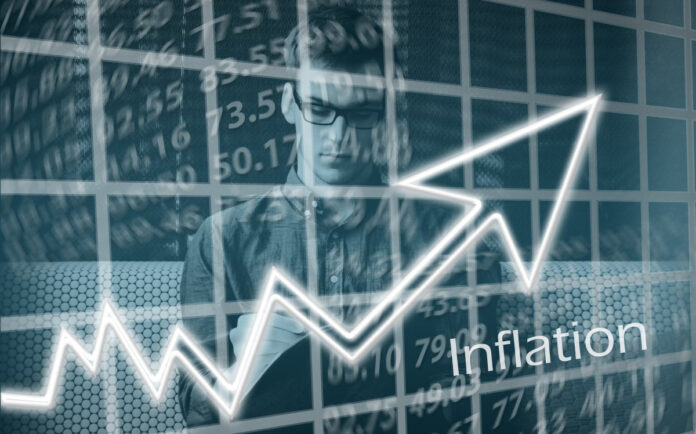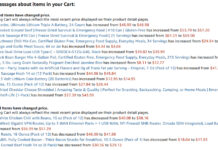Inflation is closing in on us slowly but surely. Here are some examples from recent media coverage:
- Used car prices soared 17 percent in the last seven months of 2020.
- Food inflation could be here to stay
- The inflation cycle has begun
- Inflation fears lurk
Inflation Math
Let’s look at a fictional blue-collar worker we’ll call Mark. Mark worked all sorts of overtime in 2020, was paid a bonus at year-end, combined it with his family’s stimulus checks, and by the time he got his tax refund, he was thrilled to see that he had $20,000 in the bank. He and his wife talk about investing it, but they know little about investing, and neither of them trust the ups and downs of the stock market. They decide to put their $20,000 in a money market account and hold on to it for a rainy day.
They are lucky to be in a credit union and can earn 0.5 percent interest. That means at the end of 2021, their savings have grown to $20,100. They just made an extra $100. Mark feels pretty good about that until early in 2022 he goes to Bass Pro Shops to pick up a box of 9mm shells and notices that the boat his buddy bought last year for $19,999 now costs $20,989. A year ago, he could have taken the money from his bank account and bought a new boat. Now he can’t afford to buy the boat. To make matters worse, the ammo he bought a couple years ago for $15 a box now costs $79 and they limit him to buying two boxes.
Inflation Devalues Your Money
At home that night, Mark mentions this to his wife as they eat hot dogs and baked beans with the kids. She tells him that their grocery bill would be 15 percent higher than a year ago if she wasn’t cutting back and buying cheaper food, like hotdogs or chicken thighs instead of hamburgers. He nods, thinking that gasoline is now $4 a gallon, meaning it can cost $60 or $80 to fill up his truck.
On paper, Mark’s wealth increased $100. In reality, he has less spending power than he did a year ago.
Later that year, Mark gets a six percent raise, the largest the company has ever given them. He tells his wife that maybe they can buy hamburger again and the craft beer he likes. She snorts and tells him that food inflation reached 20 percent that year. At the end of 2022, they have $20,200.50 in the bank, but inflation is in the high single digits. The next year, the CPI shows inflation reached 14 percent, but all the talking heads he sees on TV say the real rate is closer to 30 percent. He’s now getting a raise every three months, but they still can’t seem to get ahead. Every time they go to the store, prices seem to be higher than they were the last time.
Inflation in the 1970s
I remember as a kid that we could buy hamburger meat for 78 cents per pound and how angry my mother was when it went over $1 because of inflation in the late 1970s and early 1980s. We ate quite a bit of beans and wieners ourselves, plus things like pasta and cabbage. Eventually, things got better, the oil started flowing again, and prices stabilized.
I’m not so sure that will happen again. Last time, President Reagan came in and lowered taxes, reduced the size of the government, cut back on government regulations, and tightened the money supply. Right now, we have a president who wants higher taxes and more regulation, which the government has never been bigger and the money supply has catapulted upwards thanks to quantitative easing, unfunded mandates, and stimulus plans.
Strategies for Surviving Inflation
If you looked in a crystal ball and told that prices in three years would be twice what they are today, what would you do and what would you buy and stockpile? What should Mark have spent his $20,000 on?
Obviously, there are some things you can’t keep for four years, like gasoline and hamburger. But there are things that can last and may have a greater resale value in the future, after inflation, such as new-in-the-box guns and magazines or silver coins. You could also buy alcohol, and some bottles may even increase in value as they age.
There are also things you can buy today and possibly sell for more after inflation, even though they are used. Good pickup trucks have a high resale value. It would not surprise me if the truck I bought in late 2021 could sell for more than its purchasing price in 2025, even though it might have 50,000 miles on it. Houses usually appreciate during periods of inflation, as does farmland. Mark could use the $20,000 as a down payment and move to the exurbs or the country.
Put Your Money to Work
You can also buy goods that produce an income. For example, mark or his wife could go to school, get a certification, or get training in something that would allow them to get a promotion or a better paying job. He could buy equipment to support a side gig, such as making custom furniture. She could invest in a sewing machine and do home sewing.
Alternatively, they could buy livestock and sell the meat, milk, eggs, wool, or other output. Livestock also has the benefit of helping to feed the family in the face of rising food costs. They could have planted a garden as well and planted berry bushes or fruit trees.
Preppers can be Well Positioned for Inflation
Preparing for inflation isn’t too different from prepping. Stockpiling is important because you buy goods today before the next big price increases. We tend to own guns and ammo and may own other tangibles like tools. Many preppers garden and raise livestock as well.
I’ve spent more than $1,200 so far on fencing materials, wood for building a chicken coop, bee hive components, bees, and chicks, but they will go a long way to making us more resilient in a post SHTF-event. It has not escaped me that these steps towards self-sufficiency could also benefit us tremendously if we see a period of high inflation.
My Inflation List
You may recall that I have a list of products to run out and buy if we suddenly get word of a life-altering event, like China invading Taiwan, Iran and Israel going to war, or India and Pakistan exchange a few nukes. Many of the things on the list are fresh goods we can live without but would help tremendously if the world goes to hell in a handbasket for several months or more. This includes bricks of cheese, 50-pound bags of potatoes, and plenty of country ham and summer sausage (which do not need refrigeration).
I recently developed an inflation list. This includes things I would buy if I knew prices were going to soar in the next year or two. Its broad categories include food, garden supplies, solar power equipment, tools and hardware, and miscellaneous. Many of these things are items I intend to get in the future, but for cash flow purposes, I am spreading out the purchases.
Miscellaneous includes all sorts of things, like new prescription glasses for both of us, a 1×8 zoom scope, extra boots, a year’s supply of firewood, and some extra dimensional lumber I might need for projects around the house.
My advice: Keep prepping, keep stockpiling, and think about putting your money to work.







